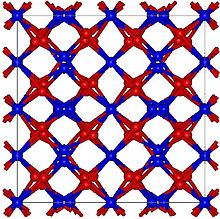Terbium(III) oxide

| |
| Names | |
|---|---|
| IUPAC name
terbium(III) oxide
| |
| Other names
terbium trioxide, terbia, terbium sesquioxide
| |
| Identifiers | |
3D model (JSmol)
|
|
| ECHA InfoCard | 100.031.668 |
| EC Number |
|
PubChem CID
|
|
CompTox Dashboard (EPA)
|
|
| |
| |
| Properties | |
| O3Tb2 | |
| Molar mass | 365.848 g·mol−1 |
| Appearance | white crystals |
| Density | 7.91 g/cm3 |
| Melting point | 2,410 °C (4,370 °F; 2,680 K) |
| 0.07834 cm3/mol | |
| Structure | |
| Cubic, cI80 | |
| Ia3, No. 206[1] | |
a = 1.057 nm
| |
| Thermochemistry | |
Std molar
entropy (S⦵298) |
156.90 J/mol·K [2] |
Std enthalpy of
formation (ΔfH⦵298) |
-1865.23 kJ/mol [2] |
Gibbs free energy (ΔfG⦵)
|
-1776.553 kJ/mol [2] |
| Hazards | |
| GHS labelling: | |
 
| |
| Warning | |
| H319, H410 | |
| P264, P273, P280, P305+P351+P338, P337+P313, P391, P501 | |
| Related compounds | |
Other anions
|
Terbium(III) chloride |
Other cations
|
Gadolinium(III) oxide Dysprosium(III) oxide |
Except where otherwise noted, data are given for materials in their standard state (at 25 °C [77 °F], 100 kPa).
| |
Terbium(III) oxide, also known as terbium sesquioxide, is a sesquioxide of the rare earth metal terbium, having chemical formula Tb
2O
3. It is a p-type semiconductor, which conducts protons, which is enhanced when doped with calcium.[3] It may be prepared by the reduction of Tb
4O
7 in hydrogen at 1300 °C for 24 hours.[4]
- Tb4O7 + H2 → 2 Tb2O3 + H2O
It is a basic oxide and easily dissolved to dilute acids, and then almost colourless terbium salt is formed.
- Tb2O3 + 6 H+ → 2 Tb3+ + 3 H2O
The crystal structure is cubic and the lattice constant is a = 1057 pm.[5]
References[edit]
- ^ Curzon A.E.; Chlebek H.G. (1973). "The observation of face centred cubic Gd, Tb, Dy, Ho, Er and Tm in the form of thin films and their oxidation". J. Phys. F. 3 (1): 1–5. Bibcode:1973JPhF....3....1C. doi:10.1088/0305-4608/3/1/009.
- ^ a b c R. Robie, B. Hemingway, and J. Fisher, "Thermodynamic Properties of Minerals and Related Substances at 298.15K and 1bar Pressure and at Higher Temperatures," US Geol. Surv., vol. 1452, 1978.[1]
- ^ Reidar Haugsrud; Yngve Larring & Truls Norby (December 2005). "Proton conductivity of Ca-doped Tb
2O
3". Solid State Ionics. 176 (39–40). Elsevier B.V.: 2957–2961. doi:10.1016/j.ssi.2005.09.030. - ^ G. J. McCarthy (October 1971). "Crystal data on C-type terbium sesquioxide (Tb
2O
3)". Journal of Applied Crystallography. 4 (5): 399–400. doi:10.1107/S0021889871007295. - ^ N. C. Baenzinger, H. A. Eick, H. S. Schuldt, L. Eyring: Terbium Oxides. III. X-Ray Diffraction Studies of Several Stable Phases. In: Journal of the American Chemical Society, 1961, 83, 10, S. 2219-23.
